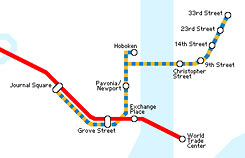A new late-night map to soften the blow of Metrorail cuts
The proposed cuts to Metrobus and Metrorail for the current fiscal year, which could go into effect as soon as January, include a plan to reduce rail headways to 30 minutes at night.
Currently, trains come about every 20 minutes on each line. Where two lines run together, headways are about 10 minutes. The Red Line has scheduled headways of 15 minutes, but with trackwork every evening as part of the years-long rebuilding process, trains have been coming at 20 minute intervals.
Reducing these headways to 30 minutes per line would make Metro one of the least frequent subways in the US. San Francisco’s BART operates 30 minute headways in the hour before it closes on weekends, but most other operators have better frequencies in the evening.
With such a large budget gap and the long-term issues facing WMATA, any solution will be very painful to riders. However, there may be ways to dull the pain.
One approach taken by some transit agencies, like Atlanta’s MARTA and New York/New Jersey’s PATH, is to eliminate duplicative services after a certain time. Atlanta subway riders who need to get from downtown to one of the Red Line stops north of Lindbergh have to use the Yellow Line to get there after 8 pm. In the New York area, PATH combines services to reduce duplication and save money.
These systems truncate unproductive segments and move those resources to providing better service in other areas. Metro could and should do the same.
One option would be to eliminate service between Rosslyn and Pentagon on the Blue Line. Since Arlington Cemetery closes earlier than the rest of the system, no one would be stranded. Instead, trains coming from Largo could provide additional service to the busy Rosslyn-Ballston corridor. For the Arlandria segment of the Blue and Yellow Lines, Franconia trains could operate over the Yellow Line bridge, at least as far as Mount Vernon Square.
If Metro is serious about reducing headways to 30 minutes, changing service patterns would be one way of softening the blow. Under this alternate proposal, frequencies on the Red Line between Grosvenor and Silver Spring would remain 15 minutes, but would drop to 30 for the farther-out segments. The Orange Line would see a drop from 20 to 30 minutes on the sections between Ballston and Vienna and Minnesota Avenue and New Carrollton. But the line would see an increase in headways from 20 minutes today to 15 minutes under this proposal between Rosslyn and Ballston.
All other segments served by one line would drop from 20 to 30 minutes and from 10 to 15 minutes for shared segments. While the Rosslyn-Pentagon segment of the Blue Line would end entirely, service between L’Enfant Plaza and Pentagon would increase from 20 minutes to 15 minutes. And in the 7th Street Subway, headways would remain about the same as they are today — 10 minutes — between L’Enfant Plaza and Mount Vernon Square.
No one wants to see cuts, and hopefully Metro’s cuts will be temporary. But it is essential that WMATA find ways of minimizing inconvenience to patrons. The risk is lower ridership and the potential for a “death spiral” of more and more painful cuts each year.



